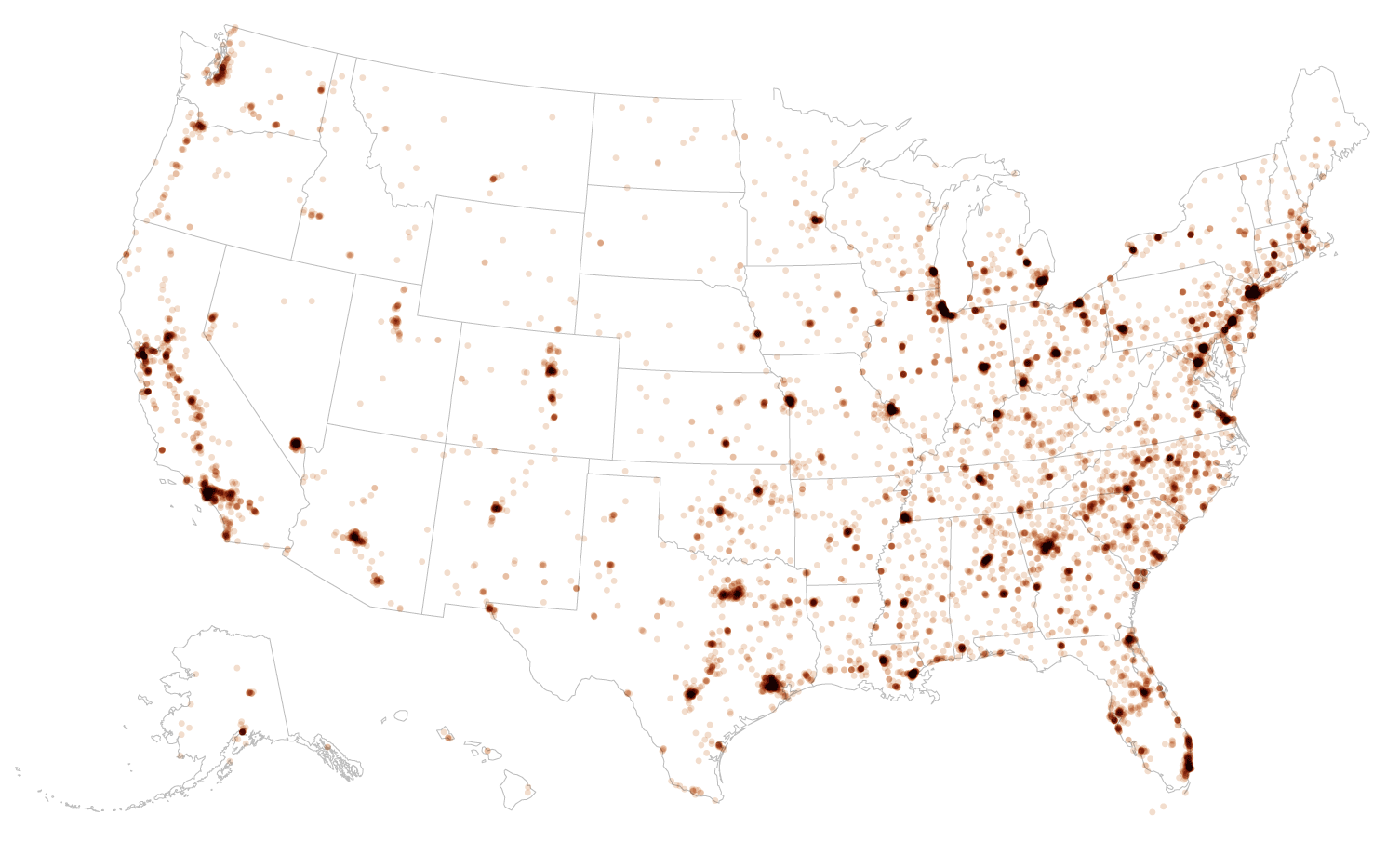Fixing Gun Violence In America
The map of America’s gun violence epidemic can seem overwhelming.
There were more than 13,000 gun homicides in the US in 2015, across
nearly 3,500 cities and towns. But the toll of this gun violence was not
distributed equally.
Half of America's gun homicides in 2015 were clustered in just 127 cities and towns, according to a new geographic analysis by the Guardian, even though they contain less than a quarter of the nation’s population.
In 2015, there were more than 13,000 gun homicides throughout the US....... … but
half of
those deaths were in just 127 cities, which contain almost a
quarter
of the population. Even within those cities, violence is further
concentrated in the tiny neighborhood areas that saw two or more gun
homicide incidents in a single year.
… but
half of
those deaths were in just 127 cities, which contain almost a
quarter
of the population. Even within those cities, violence is further
concentrated in the tiny neighborhood areas that saw two or more gun
homicide incidents in a single year.
Four and a half million Americans live in areas of these cities with the highest numbers of gun homicide, which are marked by intense poverty, low levels of education, and racial segregation. Geographically, these neighborhood areas are small: a total of about 1,200 neighborhood census tracts, which, laid side by side, would fit into an area just 42 miles wide by 42 miles long.
The problem they face is devastating. Though these neighborhood areas contain just 1.5% of the country’s population, they saw 26% of America’s total gun homicides.
Gun control advocates say it is unacceptable that Americans overall are "25 times more likely to be murdered with a gun than people in other developed countries". People who live in these neighborhood areas face an average gun homicide rate about 400 times higher than the rate across those high-income countries.
Understanding this dramatic clustering of America’s of gun violence is crucial for the effort to save more lives.
“We can’t do much about crime prevention of homicide if we try to attack it as a broad, global problem, throwing money at it in a sort of broad, global way,” said David Weisburd, a leading researcher on the geographic distribution of crime at George Mason University.
America’s gun policy debate is usually driven by high-profile mass shootings that seem to strike at random, and it focuses on sweeping federal gun control or mental health policies. But much of America’s gun homicide problem happens in a relatively small number of predictable places, often driven by predictable groups of high-risk people, and its burden is anything but random.
The concentration of gun homicides in certain census tracts mirrors what criminologists have discovered when they look at crime patterns within individual cities: roughly 1.5% of street segments in cities see about 25% of crime incidents, a trend dubbed “the law of crime concentration”.
The Guardian’s new geographic analysis is the first time that gun homicides nationwide have been mapped down to the census tract level, researchers said. This new approach was made possible with the geocoded data collected since 2014 by the not-for-profit Gun Violence Archive, which tracks shootings and gun deaths using media reports. The FBI’s national crime data only provides gun murder statistics down to the city level, which masks the clustering of violence within neighborhoods................. Case study: St Louis
Let's take a look at St Louis, which has the highest gun murder rate of any large city in the country.......... Homicides are concentrated in areas of high poverty. And the lowest educational attainment. And the neighborhoods forged out of decades of racial segregation.
The clear dividing line you see between areas with many gun homicides and few gun homicides is Delmar Boulevard, which has developed over time into a rigid racial boundary that carves the city in two...........
Read more dispatches from St Louis, north of Delmar Boulevard »
For the greater part of the 20th century, racial housing covenants, discriminatory lending practices and “white flight” imposed de facto segregation as pronounced as any ever achieved by Jim Crow on St Louis’ black residents. Even today, some residents treat Delmar Boulevard as a line they do not want to cross. In May, a group of parents canceled a kindergarten Little League game held in a park north of Delmar Boulevard, telling the opposing team that they were “uncomfortable with the location” of their home field, a decision a home team parent called “racist”................
In New York, a city of eight million people, only 1.5% of census tracts saw two or more gun homicide incidents in 2015. That’s a much lower percentage than St Louis, where a shocking 44% of census tracts saw multiple gun homicides in 2015.
Compared with St Louis, New York also has much broader swathes of the city that saw no gun homicides at all.
New York City’s murder rate of about four murders per 100,000 people is neatly in line with the national average...........
New Orleans, Louisiana
..........................22% of New Orleans census tracts saw multiple gun homicides, and these areas were responsible for more than 75% of the murders. The concentration of violence in New Orleans is closest to the concentration in Baltimore.